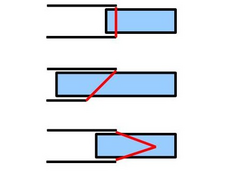surely that is for alignment - is I had a jig to align both tube and rod perfectly ,then 1 or 2 mm is enough?
the blob of weld isn't going to go far inside the tube needing the rod to be trhere, as below?
weld rod/tube
[Edited on 6/8/10 by 02GF74]

let's say you wish to extend a 14 mm diameter steel rod using 3 mm wall tube welded over the rod.
what is the minimum amount of overlap of tube over the rod?
I would have thought 0.5 x diameter is enough providing the whole assemly is still concentric or not?
i would want quite a bit more, i dont know why but id just want it a bit stronger?
I would probably fishmouth the ends and drill and plug weld aswell to make sure its still strong.
Depends what application its for really
^^^^ hmmm I should have said the arrangement will have twisting forces only e.g. a steering column so the amont of rod inside the tube is IMO not adding strength; the bead of weld is doing all that.
i would have said the more rod you have in the tube the easier it will be to ensure its straight. will the tube be exactly 14mm ID?
i would have still said a fishmounh on either end to give more streangth, dont want your steering breaking
I would use 4X the diameter of the shaft. Fishmouth the sleeve and, a hole drilled into the middle of the fishmouth and welded in that.
I'd go with at least 4 times the diameter, and slash cut the tube so you get a longer weld bead.
I'm confused - please can someone explain why 4x diameter is recommended iside the tube?
surely that is for alignment - is I had a jig to align both tube and rod perfectly ,then 1 or 2 mm is enough?
the blob of weld isn't going to go far inside the tube needing the rod to be trhere, as below?
weld rod/tube
[Edited on 6/8/10 by 02GF74]
I would give it 25mm each side and drill a hole through, pin and weld it.
I would use Roll Pins no welds ------- or bronze weld and use roll pins.
Normal forum situation - 1 question, 10 different answers! 
I can only offer what I did with my steering extension - the tubing went over the cut ends of the old steering link for about 2" (simply because
it was convenient). The tube was a very close fit over the rod. I had cross-drilled the tube to make 2 holes about 5 or 6mm diameter. I welded
around the tube end to make a strong connection, then 'puddled' some weld into the cross-drilled holes as 'back-up' to the main
weld.
It worked for me, but I couldn't/wouldn't say that it was the best way. It was just one way of doing it. I probably wouldn't bother
with the cross-drilling and puddle welding if I was doing it again, as all I did was create a new stress concentration point.
It's worth considering the forces on a steering column - probably not very high. If they are high enough to break a half-decent weld, you
probably couldn't hold onto the wheel! The main concern must be fatigue fractures caused by minor but repeated shocks, so really we should be
doing whatever's necessary to make a long-term reliable joint.
BT's suggestion of bronze-welding would do the job, as that's astonishingly strong as long as there's sufficient contact area between
the two parts (assuming that the job's done properly).
Note: this is entirely my opion, based on personal experience rather than engineering qualifications!
[Edited on 6/8/10 by David Jenkins]
Hi
25-30mm overlap with weld. And 1/8th double roll pin. Be sure to align the joints either end if attached to the shaft rather than a spline at either
end.
HD double roll pin

Cheers Matt
Worth remembering that Senna may well have died due to a weld failing on an extended steering column. Presumably done by someone who had some talent
at welding.
So I'm not sure about the point trying to optimise the weight of the tube/minimise material, for steering (even more than brakes IMO), you want
as safe and strong as possible.
I'd hope the 'weld' blob in your diagram isn't showing two tack welds but you intend a continuous weld at minimum. A slash cut or
fishmouth cut will allow a lot more weld length, something that will be stronger.


Description
Though I'd be using a couple of roll-pins at 90 degrees as additional security personally.
nope - not tack welds - it would be welded all the way round.